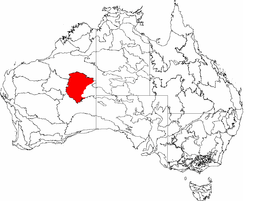Gibson Desert
| Gibson | |
| Desert | |
 The typical appearance of the Gibson Desert | |
| Country | Australia |
|---|---|
| State | Western Australia |
| Area | 156,000 km2 (60,232 sq mi) |
| Biome | Desert |
 The IBRA-defined boundaries of the Gibson Desert | |

The Gibson Desert, an interim Australian bioregion, is a large desert that covers a large dry area in the state of Western Australia and is still largely in an almost "pristine" state. It is about 155,000 square kilometres (60,000 sq mi) in size, making it the 5th largest desert in Australia, after the Great Victoria, Great Sandy, Tanami and Simpson deserts.
Location and description
The Gibson Desert is located between the saline Lake Disappointment and Lake Macdonald along the Tropic of Capricorn, south of the Great Sandy Desert, east of the Little Sandy Desert, and north of the Great Victoria Desert. The altitude rises to just above 500 metres (1,600 ft) in places. As noted by early Australian explorers such as Ernest Giles[1] large portions of the desert are characterized by gravel-covered terrains covered in thin desert grasses and it also contains extensive areas of undulating red sand plains and dunefields, low rocky/gravelly ridges and substantial upland portions with a high degree of laterite formation. The sandy soil of the lateritic buckshot plains is rich in iron. Several isolated salt-water lakes occur in the centre of the region and to the southwest a system of small lakes follow paleo-drainage features.[2] Groundwater sources include portions of the Officer Basin and Canning Basin.
Rainfall in the Gibson Desert ranges from 200 millimetres (7.9 in) to 250 millimetres (9.8 in) annually, while evaporation rates are in the range of 3,600 millimetres (140 in) per year. The climate is generally hot; summer maximum temperatures rise above 40 °C (104 °F) whilst in winter the maximum may fall to 18 °C (64 °F) and minimum winter temperatures dip to 6 °C (43 °F).[3]
History
The Gibson Desert was named by explorer Ernest Giles after a member of his party, Alfred Gibson, who became lost and presumably died in this desert during an expedition in 1874.[1]
Indigenous habitation
In much of the region, especially the drier western portion, the majority of people living in the area are Indigenous Australians. In 1984, due to a severe drought which had dried up all of the springs and depleted the bush foods, a group of the Pintupi people who were living a traditional semi-nomadic desert-dwelling life, walked out of a remote wilderness in the central-eastern portion of the Gibson Desert (northeast of Warburton) and made contact for the first time with Australian society. They are believed to have been perhaps the last uncontacted tribe in Australia. On the eastern margin of the region, population centres (which include people of European descent) include Warburton, Mantamaru and Warakurna. Young Indigenous adults from the Gibson Desert region work in the Wilurarra Creative programs to maintain and develop their culture.[4]
See also
References
- 1 2 Giles, Ernest (1889). Australia twice traversed: the romance of exploration, being a narrative compiled from the journals of five exploring expeditions into and through central South Australia and Western Australia from 1872 to 1876. 2. London: Sampson Low, Marston, Searle & Rivington. ISBN 0-86824-015-X. Retrieved 2012-05-12.
- ↑ "Rangelands - Overview - Gibson Desert". Australian Natural Resources Atlas. Department of Sustainability, Environment, Water, Population and Communities. 27 June 2009. Archived from the original on 16 March 2011. Retrieved 19 December 2010.
- ↑ Great Victoria and Gibson Deserts, Western Australia from Climate and Weather Atlas of Australia by Michael Thompson, verified 2006-01-23.
- ↑ Wilurarra Creative 2011
Further reading
- Thackway, R and I D Cresswell (1995) An interim biogeographic regionalisation for Australia : a framework for setting priorities in the National Reserves System Cooperative Program Version 4.0 Canberra : Australian Nature Conservation Agency, Reserve Systems Unit, 1995. ISBN 0-642-21371-2
External links
![]() Media related to Gibson Desert at Wikimedia Commons
Media related to Gibson Desert at Wikimedia Commons
- Gibson Desert 1997; a photo album of the Gibson Desert by Stuart Jackson, Verified 2006-01-23
- Across Australia Motorbike Tour
Coordinates: 23°S 125°E / 23°S 125°E